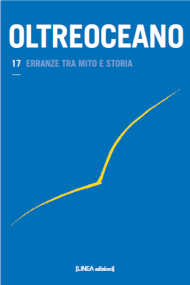Il mito dell’emancipazione nera in due romanzi della Harlem Renaissance
DOI:
https://doi.org/10.53154/Oltreoceano5Keywords:
New Negro Movement, Harlem Renaissance, contro-mitoAbstract
Questo saggio esamina due romanzi della Harlem Renaissance: There Is Confusion (1924) di Jessie
Redmon Fauset e Infants of the Spring (1932) di Wallace Thurman. In entrambi è possibile trovare una rappresentazione contro-mitica delle speranze di emancipazione rispetto ai canoni e ai valori bianchi che la cultura afroamericana nutrì, e solo in parte realizzò, tra gli anni Venti e Trenta del Novecento.
The Myth of Black Emancipation in Two Novels of the Harlem Renaissance
This essay focuses on two novels of the Harlem Renaissance: Jessie Redmon Fauset’s There is
Confusion (1924) and Wallace Thurman’s Infants of the Spring (1932). Both novels offer a counter-
mythical representation of black artists’ hope to emancipate themselves from white canons and
values in the 1920s and 1930s.
Downloads
References
Dickson-Carr, D. (2001): African American Satire: The Sacredly Profane Novel. Columbia: University of Missouri.
Dickson-Carr, D. (2015): Spoofing the Modern: Satire in the Harlem Renaissance. Columbia: University of South Carolina Press.
Fauset, J.R. (1990): There Is Confusion (Thadious M. Davis Ed.). Boston: Northeastern University Press.
Ganter, G. (2008): Decadence, Sexuality, and the Bohemian Vision of Wallace Thurman. In A. Tarver and P.C. Barnes (Eds.), New Voices on the Harlem Renaissance: Essays on Race, Gender, and Literary Discourse (pp. 192-213). Madison: Fairleigh Dickinson University Press.
Herring, T.S. (2001): The Negro Artist and the Racial Manor: Infants of the Spring and the Conundrum of Publicity. Rivista African American Review, 35 (4), pp. 581-597.
Hutchinson, G. (2004): The Novel of the Negro Renaissance. In M. Graham (Ed.), The Cambridge Companion to the African American Novel (pp. 50-69). Cambridge, Cambridge University Press.
Kuenz, J. (1999): The Face of America: Performing Race and Nation in Jessie Fauset’s There Is Confusion. Journal The Yale Journal of Criticism, 12, 1, pp. 89-111.
Levering Lewis, D. (1989): When Harlem Was in Vogue. Oxford: Oxford University Press.
Levison, S. (2000): Performance and the Strange Place of Jessie Redmon Fauset’s There is Confusion. MFS Modern Fiction Studies, 46, 4, pp. 825-848.
McDowell, D. E. (1981): The Neglected Dimension of Jessie Redmon Fauset. Afro-Americans in New York Life and History (1977-1989), 5, 2, pp. 33-49.
McKaye, C. (1993): Home to Harlem. Wayne F. Cooper (Ed.). Boston: Northeastern University Press.
Miller, N. (1996): Femininity, Publicity, and the Class Division of Cultural Labor: Jessie Redmon Fauset’s There Is Confusion. Journal African American Review, 30, 2, pp. 205-220.
Ross, Marlon B. (2013): Racial Uplift and the Literature of the New Negro. In G. A. Jarrett (Ed.), A Companion to African American Literature (pp. 151-167). Oxford, Wiley-Blackwell.
Schenck, M. J. (2001): Jessie Fauset: The Politics of Fulfillment vs. the Lost Generation. South Atlantic Review, 66, 1, pp. 102-125.
Thurman, W. (2006): Infants of the Spring (Amritjit Singh Ed.). Boston: Northeastern University Press.
Thurman, W. (2008): The Blacker the Berry. New York: Dover.
Walker, D. E. (1998): Exploding the Canon: A Re-examination of Wallace Thurman’s Assault on the Harlem Renaissance. Western Journal of Black Studies, 22, 3, pp. 153-158.
Watts, E. K. (2012): Hearing the Hurt: Rhetoric, Aesthetics, and Politics of the New Negro Movement. Tuscaloosa: University of Alabama Press.
Downloads
Published
How to Cite
Issue
Section
License

This work is licensed under a Creative Commons Attribution-NonCommercial-ShareAlike 4.0 International License.
The authors undertake to comply with the following conditions, which are considered accepted at the time of submission of their contributions.
The sending of a text implies that it is unpublished and not submitted to be published elsewhere.
1. If accepted, the author shall confer on the publisher the right to publish and distribute it both in paper form and in the online electronic edition. The published articles will be downloadable and made available in open access.
2. Provided that it correctly indicates that the first publication took place in the journal Oltreoceano. Rivista sulle migrazioni the author has the right to: a) reproduce the article in separate extracts or collected in a volume; b) publish the article on their personal website or teaching site provided that these sites are of a non-commercial nature; c) deposit the article in online archives of a non-commercial nature, linked to the institution they belong to or as part of projects for the non-commercial dissemination and open access of scientific works.
The use of contributions by third parties, for commercial or otherwise unauthorized purposes, is not allowed. The publisher declines all responsibility for the unauthorized use of the material published in the journal.












